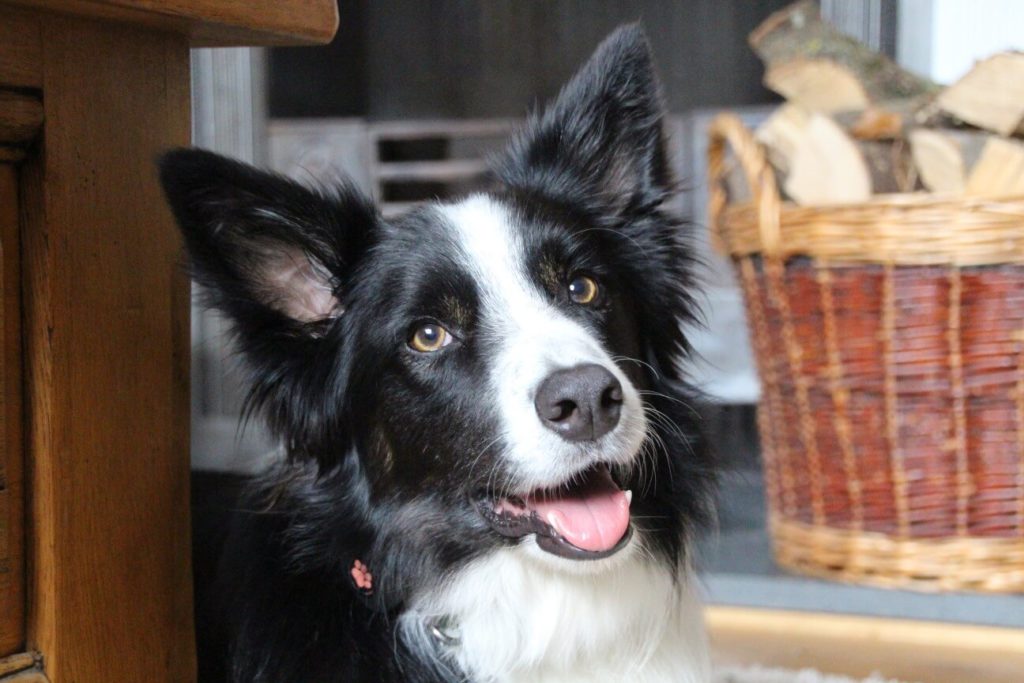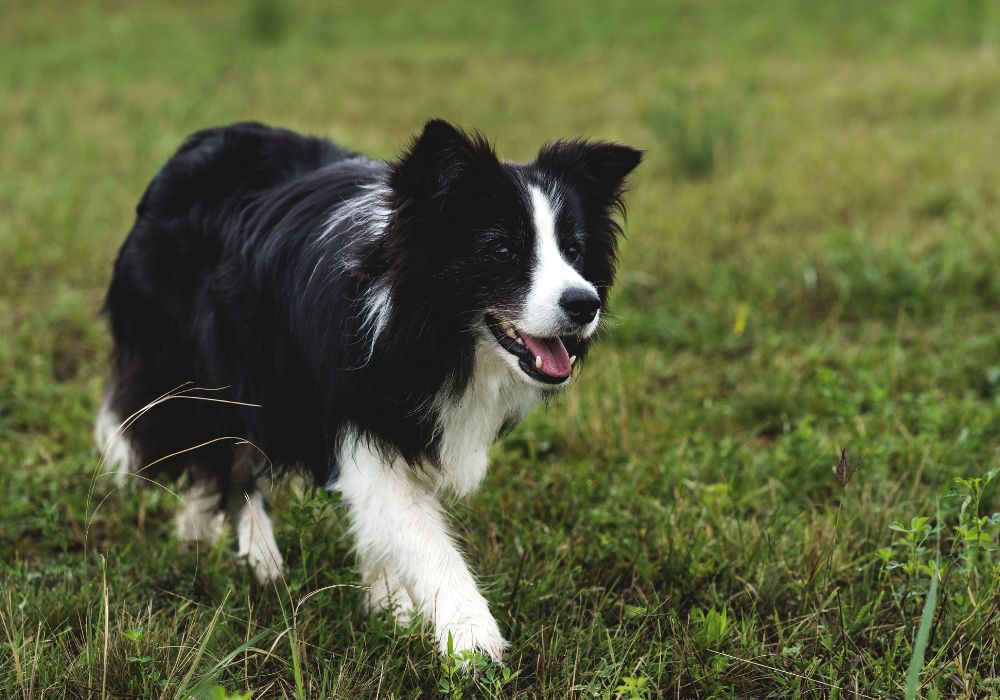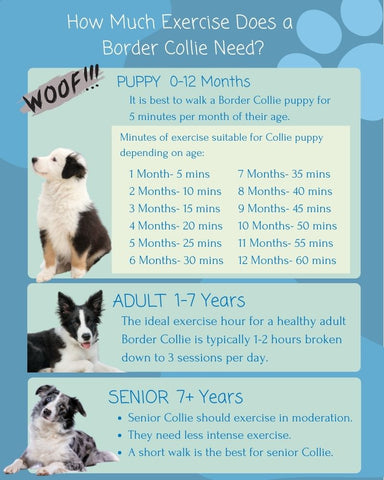A Border Collie puppy needs regular exercise. But how often should you walk one?
Border Collie puppies are energetic and smart. They need physical and mental activity to stay happy and healthy. Walking is a great way to meet these needs. Regular walks help burn off energy and prevent boredom. It’s important to know how often to walk your puppy to keep them in the best shape.
Too little walking can lead to pent-up energy and bad behavior. Too much walking can be hard on their growing joints. Finding the right balance is key. In this post, we’ll explore the ideal walking schedule for your Border Collie puppy. This will help you keep your furry friend active and content.

Credit: zigzag.dog
Benefits Of Walking A Border Collie Puppy
Walking a Border Collie puppy provides numerous benefits for their overall well-being. These active and intelligent dogs need regular walks to stay healthy and happy. Let’s explore the key benefits of walking your Border Collie puppy regularly.
Physical Health
Regular walks are essential for maintaining your Border Collie puppy’s physical health. Daily exercise helps build strong muscles and bones. It also supports cardiovascular health. Without enough physical activity, puppies can become overweight. This can lead to health issues like joint problems.
Walks also help with digestion. Physical activity ensures that their digestive system works properly. It reduces the risk of constipation and other digestive issues. Also, a well-exercised puppy is less likely to develop obesity-related conditions.
Mental Stimulation
Border Collies are known for their intelligence. They need mental stimulation to stay sharp and happy. Walks provide them with new sights, sounds, and smells. These experiences keep their minds engaged. They also help prevent boredom, which can lead to destructive behaviors.
During walks, your puppy can interact with different environments. This helps with socialization and reduces anxiety. It also teaches them to be comfortable in various situations. Regular walks can significantly improve your puppy’s mental well-being.

Credit: www.pitpat.com
Ideal Walking Schedule
Walking a Border Collie puppy is crucial for their health and happiness. These energetic dogs need regular exercise to stay fit and entertained. Let’s explore the ideal walking schedule for your Border Collie puppy.
Frequency
Border Collie puppies are full of energy and curiosity. They need frequent walks to burn off this energy. A good rule of thumb is to walk them at least three times a day. This helps keep their energy levels balanced and prevents destructive behavior.
Here is a suggested schedule:
- Morning walk: 20-30 minutes
- Afternoon walk: 20-30 minutes
- Evening walk: 20-30 minutes
Duration
The duration of each walk should be tailored to your puppy’s age and stamina. Puppies have shorter attention spans and get tired quickly. Keep walks short and enjoyable to prevent over-exertion.
Use the following guidelines for the duration of walks:
| Age | Duration per Walk |
|---|---|
| 8-12 weeks | 10-15 minutes |
| 3-6 months | 20-30 minutes |
| 6-12 months | 30-40 minutes |
Remember, always observe your puppy during walks. If they appear tired or stressed, it’s time to head home.
These walks are not just for physical exercise. They also provide mental stimulation. New sights, sounds, and smells help your puppy learn and grow. Keep walks varied and interesting to maximize their benefits.
Adjusting Walks As They Grow
Adjusting walks as your Border Collie puppy grows is important. Their exercise needs change with age. Regular walks help maintain their health. A structured routine ensures balanced growth and development. Below are tips for adjusting walks at different growth stages.
Puppy Stages
During the early months, your Border Collie puppy is full of energy. Short walks are ideal. Keep walks to around 5 minutes per month of age. This avoids over-exertion. Puppies also need playtime in a safe area. This helps them burn off energy.
As they grow, gradually increase the walk duration. Monitor their behavior. If they seem tired, reduce the walk time. Always use a leash to keep them safe. Puppies can get distracted easily. A leash helps control their movements. Consistent, gentle walks build their stamina.
Adult Transition
At around 12 months, your Border Collie puppy enters adolescence. They start to need longer walks. Aim for about 30-60 minutes daily. Split this into two sessions. This keeps them active and engaged. They also benefit from different walking environments.
Observe their energy levels. Adjust the walk duration accordingly. Some days they may need more exercise. Other days, a shorter walk suffices. Mental stimulation is crucial too. Incorporate training during walks. Teach them new commands. This keeps their mind sharp.
Balanced exercise during this stage supports their transition to adulthood. It helps them develop strong muscles and healthy joints. Regular walks also strengthen your bond with your Border Collie. They look forward to this shared time with you.
Signs Of Overexertion
Understanding the signs of overexertion in your Border Collie puppy is crucial. Puppies have boundless energy, but they can also tire quickly. Knowing how to spot overexertion can help keep your puppy healthy and happy.
Physical Indicators
Watch for heavy panting in your Border Collie puppy. Excessive drooling is another sign. Check if your puppy’s gums are pale. This can indicate exhaustion. Limping or stiffness also points to overexertion. Notice any unusual thirst. It can be a sign your puppy is too tired.
Behavioral Changes
Your puppy may become less playful. They might lie down more often. Reluctance to move or walk is a red flag. Some puppies can become irritable. They might snap or growl more. Pay attention to changes in their sleep patterns. Extra sleep can mean they are overexerted.
Incorporating Playtime
Incorporating playtime into your Border Collie puppy’s walking routine is essential. Playtime helps stimulate their mind and body. It also strengthens your bond with them. Let’s explore some ways to make playtime fun and beneficial.
Interactive Games
Interactive games keep your puppy’s mind sharp. These games can be as simple as fetch. Use a soft toy or ball. Another great game is tug-of-war. This game builds their muscles and teaches them to release on command. Try hiding treats around your yard. Let your puppy find them. This game is great for mental stimulation.
Socialization Opportunities
Socialization is key for a well-behaved Border Collie. Arrange playdates with other puppies. This helps them learn social cues. Puppy classes can also be helpful. They provide a controlled environment for learning. Visiting dog parks is another option. Your puppy will meet dogs of all sizes and breeds. This exposure is important for their development.

Credit: petstek.com
Weather Considerations
Weather plays a crucial role in determining how often you should walk your Border Collie puppy. Different weather conditions can impact your puppy’s health and comfort. Understanding how to adjust your walking schedule based on weather is vital for your puppy’s well-being.
Hot Weather Tips
In hot weather, walk your puppy early in the morning or late in the evening. The cooler temperatures help prevent overheating. Always carry water to keep your puppy hydrated. Avoid walking on hot pavement. It can burn your puppy’s paws. Test the ground with your hand. If it’s too hot for your hand, it’s too hot for your puppy. Stick to shaded paths and grassy areas. Limit the duration of walks to prevent heat exhaustion.
Cold Weather Tips
Cold weather requires extra precautions. Dress your puppy in a warm coat if it’s very cold. Short walks are better in freezing temperatures. Avoid walking on icy paths to prevent slipping. Check your puppy’s paws for ice buildup or frostbite. Wipe their paws after walks to remove any salt or chemicals. Keep an eye on your puppy for signs of discomfort.
Training During Walks
Training during walks is crucial for a Border Collie puppy. Walks are not just for exercise. They are also for learning and bonding. Your puppy can learn many commands and behaviors on walks.
Basic Commands
Teach your Border Collie puppy basic commands during walks. Start with simple commands like sit, stay, and come. Use treats as rewards. Consistency is key. Give the command, then reward the puppy for following it.
Gradually introduce more complex commands. For example, teach the puppy to heel. This means walking beside you without pulling. Use short training sessions. Keep them fun and positive. Your puppy will learn faster.
Leash Training
Leash training is essential for a Border Collie puppy. Begin with a comfortable collar and lightweight leash. Let the puppy get used to wearing them. Keep the leash short but not tight.
Start walking slowly. If the puppy pulls, stop walking. Wait for the puppy to return to your side. Praise and reward the puppy when it does. Repeat this process. Your puppy will learn not to pull on the leash.
Use treats to guide the puppy. Hold a treat by your side. Encourage the puppy to follow it. Reward the puppy for walking beside you. This reinforces good leash behavior.
Practice in different environments. Walk in the park, on sidewalks, and in quiet areas. This helps the puppy adapt to various surroundings. Consistent practice makes leash training easier.
Balancing Rest And Activity
Border Collie puppies need frequent walks to stay healthy and happy. Aim for short walks three to four times daily. This balances their energy and rest needs effectively.
Balancing rest and activity is crucial for a Border Collie puppy. Puppies need exercise for growth. They also need rest to recover. Striking the right balance ensures a happy, healthy puppy.Importance Of Rest
Rest is essential for your Border Collie puppy. It helps their muscles grow stronger. It also aids in brain development. Without enough rest, your puppy can become stressed. This can lead to health problems. So, make sure your puppy has quiet time each day.Creating A Routine
A consistent routine helps your puppy. Set specific times for walks and rest. This helps them know what to expect. It also makes training easier. Start with short walks. Gradually increase the length as your puppy grows. Always watch for signs of tiredness. If your puppy seems tired, let them rest.Frequently Asked Questions
How Often Should I Walk My Border Collie Puppy?
A Border Collie puppy needs daily walks. Aim for two short walks, around 15-20 minutes each, to keep them active.
Can I Over-exercise A Border Collie Puppy?
Yes, over-exercising can harm a puppy’s developing joints. Stick to short, controlled walks and avoid excessive running or jumping.
What Is The Best Time To Walk A Border Collie Puppy?
Walk your Border Collie puppy in the morning and evening. Avoid the hottest parts of the day to prevent overheating.
How Long Should Each Walk Be For A Border Collie Puppy?
Each walk should be about 15-20 minutes. This duration is ideal for their energy levels and growing bodies.
Conclusion
Walking your Border Collie puppy requires consistency and attention to their needs. A balanced routine helps them grow healthy and happy. Short, frequent walks suit their high energy levels. Ensure each walk is engaging and fun. Observe your puppy’s behavior for signs of tiredness.
Adjust walk times as they age and grow. Always prioritize their comfort and safety. Regular walks not only exercise their bodies but also stimulate their minds. A happy puppy leads to a happy home. Keep your Border Collie puppy active and loved.
